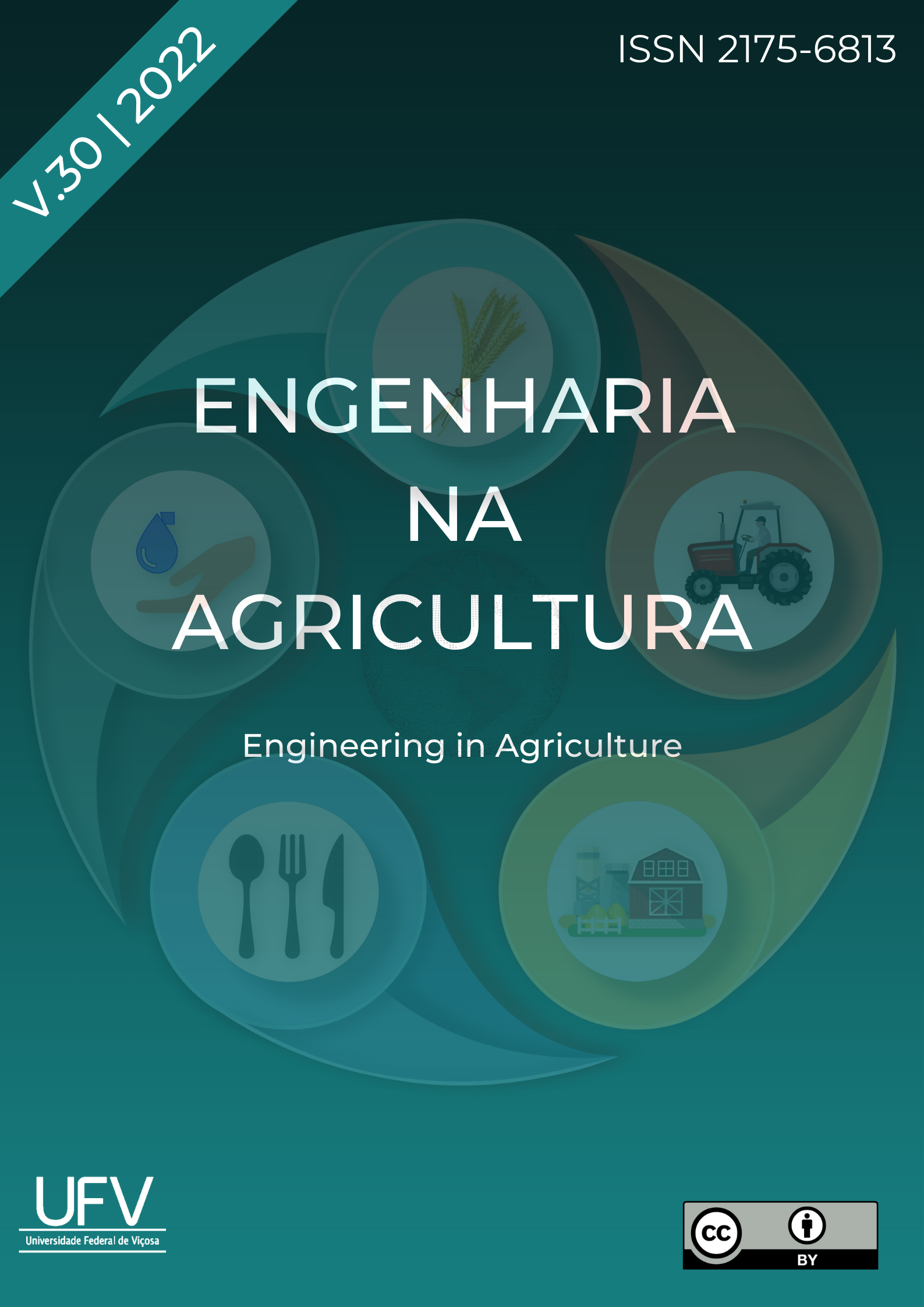Analysis of pest incidence on apple trees validated by unsupervised machine learning algorithms
DOI:
https://doi.org/10.13083/reveng.v30i1.12919Keywords:
Pest management; Unsupervised Machine Learning; Orchards; ApplesAbstract
Integrated pest control is a practice commonly used in apple orchards in southern Brazil. This type of management is an important tool to help improve quality and increase yields. This study aimed to identify areas with higher and lower incidence of aerial pests in a commercial apple orchard, regarding data collected from three different crops using georeferenced traps. Geostatistical analyses were performed, based on the modeling of semivariograms and spatial interpolation using the kriging method; and clustering, based on specific unsupervised machine learning algorithms for count data. The algorithms were selected from measures of stability, connectivity and homogeneity, seeking to identify areas with different incidence of pests that could help farmer decision making regarding insect population control using pesticides. The geostatistical analysis verified the presence of individual pest infestations in specific sites of the study area. Additionally, the analysis using machine learning allowed the identification of areas with incidence above the average for all analyzed pests, especially in the central area of the map. The process of evaluation described in this study can serve as an aid for risk analysis, promoting management benefits and reducing cost in the farms.
Downloads
References
BONIECKI, P.; KOSZELA, K.; PIEKARSKA-BONIECKA, H.; WERES, J.; ZABOROWICZ, M.; KUJAWA, S.; MAJEWSKI, A.; RABA, B. Neural identification of selected apple pests. Computers and Electronics in Agriculture, Amsterdam, v. 110, p. 9-16, 2015.
BRUNELLI, D.; ALBANESE, A.; D’ACUNTO, D.; NARDELO, M. Energy neutral machine learning based iot device for pest detection in precision agriculture. IEEE Internet of Things Magazine, [s.l.], v. 2, n. 4, p. 10-13, 2019.
CANDEIA, M. G.; GEBLER, L.; BUENO, M. B. Uso da AP no gerenciamento de metadados de longo prazo de monitoramento de pragas da macieira. In: CONGRESSO BRASILEIRO DE AGRICULTURA DE PRECISÃO – CONBAP, 2016, Goiânia. Anais [...]. Goiânia: Sociedade Brasileira de Engenharia Agrícola, 2016.
Dinardo-Miranda, L. L.; Vasconcelos, A. C. M.; Veira, S. R.; Fracasso, J. V.; Grego, C. R. Uso da geoestatística na avaliação da distribuição de Mahanarva fimbriolata em cana-de-açúcar. Bragantia, Campinas, v. 66, p. 449-455, 2007.
FIORAVANÇO, J. C.; DOS SANTOS, R. S. S. (Ed.). Maçã - o produtor pergunta, a Embrapa responde. Brasília: Embrapa, 2013.
JAIN, A. K.; DUBES, R. C. Algorithms for clustering data. Hoboken: Prentice-Hall, 1988.
JENKS, G. F. The data model concept in statistical mapping. International yearbook of cartography, [s.l.], v. 7, p. 186-190, 1967.
KOVALESKI, A.; RIBEIRO, L. G. Manejo de pragas na produção integrada da maçã. Bento Gonçalves: Embrapa Uva e Vinho, 2002.
LAZZAROTTO, J. J. Indicadores econômicos e financeiros em sistemas típicos de produção de maçã no Brasil. Bento Gonçalves: Embrapa Uva e Vinho, 2018.
MCHUGH, M. L. Interrater reliability: the kappa statistic. Biochemia medica, Zagreb, v. 22, n. 3, p. 276-282, 2012.
MOON, T. K. The expectation-maximization algorithm. IEEE Signal processing magazine, [s.l.], v. 13, n. 6, p. 47-60, 1996.
PROTAS, J. F. S.; SANHUEZA, R. M. V. Normas Técnicas e Documentos de Acompanhamento da Produção Integrada de Maçãs. Bento Gonçalves: Embrapa Uva e Vinho, 2002.
QGIS. A Free and OpenSource Geographic Information System. Available in: https://qgis.org. Access in: July 26, 2021.
ROGGIA, S.; BUENO, A. de F.; OLIVEIRA, M. C. N. de; GREGO, C. R.; VICENTE, A. K.; VICENTE, L. E. Controle localizado. Cultivar Grandes Culturas, v. 21, n. 263, p. 24-28, 2021.
SEKULA, M.; DATTA, S.; DATTA, S. OptCluster - An R package for determining the optimal clustering algorithm. Bioinformation, [s.l.], v. 13, n. 3, p. 101, 2017.
SI, Y.; LIU, P.; LI, P.; BRUTNELL, T. P. Model-based clustering for RNA-seq data. Bioinformatics, Oxford, v. 30, n. 2, p. 197-205, 2014.
UEDA, N.; NAKANO, R. Deterministic annealing EM algorithm. Neural networks, [s.l.], v. 11, n. 2, p. 271-282, 1998.
VAN LAARHOVEN, P. J. M.; AARTS, E. H. L. Simulated annealing: Theory and applications. Dordrecht: Springer, 1987.
VIEIRA, S. R.; GARCIA, M. A. G.; GONZÁLEZ, A. P.; SIQUEIRA, G. M. Variabilidade espacial e temporal do teor de água do solo sob duas formas de uso. Bragantia, Campinas, v. 69, n. 1, 2010
VIERA, A. J.; GARRETT, J. M. Understanding interobserver agreement - The kappa statistic. Fam med, Leawood, v. 37, n. 5, p. 360-363, 2005.
WITTEN, I. H.; FRANK, E.; HALL, M. A. Data Mining: Practical Machine Learning Tools and Techniques. 3rd ed. London: Morgan Kaufmann, 2011.
WRZESIE?, M.; TREDER, W.; KLAMKOWSKI, K.; RUDNICKI, W. R. Prediction of the apple scab using machine learning and simple weather stations. Computers and Electronics in Agriculture, Amsterdan, v. 161, p. 252-259, 2019.
Downloads
Published
How to Cite
Issue
Section
License
Copyright (c) 2022 Engineering in Agriculture

This work is licensed under a Creative Commons Attribution-NonCommercial 4.0 International License.
Authors who publish with this journal agree to the following terms:
The author(s) authorize(s) the publication of the text in the journal;
The author(s) ensure(s) that the contribution is original and unpublished and that it is not in the process of evaluation by another journal;
The journal is not responsible for the views, ideas and concepts presented in articles, and these are the sole responsibility of the author(s);
The publishers reserve the right to make textual adjustments and adapt texts to meet with publication standards.
From submission, the author is fully conceding the paper's patrimonial rights to the publication, but retaining the owner of its moral rights (authorship and paper's identification) according to Creative Commons Attribution-Noncommercial.








 Licensed by
Licensed by 